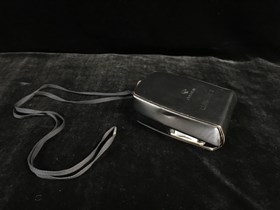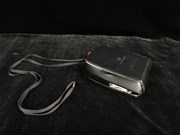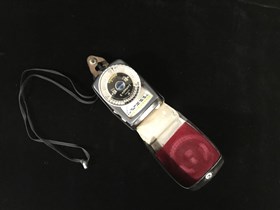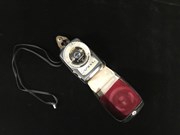- Date
- 1933 – 1949
- Material
- plastic; paint; leather; metal; fabric
- Catalogue Number
- 104.41.1123 a-b
- Description
- (a)Gossen Lunasix exposure and colour meter in a pear shape with leather case. The light meter device measures the amount of light that is appropriate to achieve the proper exposure, indicating for the users which shutter speed and f-number should be selected. Along the top of the exposure meter in…
1 image
- Title
- Exposure Meter
- Date
- 1933 – 1949
- Material
- plastic; paint; leather; metal; fabric
- Dimensions
- (a)2.5; (b)04.5 x (a)6.5; (b)7.5 x (a)11.5; (b)12.0 cm
- Description
- (a)Gossen Lunasix exposure and colour meter in a pear shape with leather case. The light meter device measures the amount of light that is appropriate to achieve the proper exposure, indicating for the users which shutter speed and f-number should be selected. Along the top of the exposure meter in the viewer left corner is a white bulb-like part next to an open circular window that measures the amount of light present in the scene. When the converter slide, located along the viewer right side, is moved to the right and clicked into position the round window is open and ready to read the scene. At the top, on the face of the meter, the light measurement (scale) is present. This shows how much light is present in the scene and directly relates to the remaining scales on the meter. Below the light scale is a plexiglass film-speed setting disc with grooves that allow the operator to easily move the dial. In the middle of the dial there is the Lunasix manufacturer symbol. On viewer left side of this emblem is the DIN exposure index of the film in use; on the proper right side of this emblem is the ASA exposure index of the film in use. By moving the dial one adjusts the film-speed setting, which is indicated in the DIN and ASA boxes, whereby the index number is lined up against the triangular white marker in the respective window. A manual would have originally been sold with the object giving a more comprehensive overview of the film-speed table with a technical appendix. On the rear of the object in the viewer right corner one will see the correct position of the 2 batteries indicated through a tiny diagram. Below this is a metal battery chamber. Below this are the words “2 Batt. Mallory” “PX 625 o. PX 13”. To the viewer left of this writing is the ridged slide used for battery testing. Above the ridged slide are the words “Batt. Contr.” with a solid arrow below. Below the battery information is the table of footcandle (LUX) equivalents. In the middle of the table is the zero adjustable screw with an arrow pointing in both directions. AT the very bottom painted on the surface is the location of manufacturing; “GERMANY (WEST)” above a cutout window revealing the patent number; “4D01673”. (b) There is also a black leather case with the object. The inside of the case has gray suede lining, which would have helped avoid scratching and marking of the meter. The case has been carefully designed to retrofit the meter, which is apparent through the tiny leather strap present when the case is opened. These designs allow the object to be formly held into place further safeguarding it. At the bottom of the case there is a black button that allows the case to be opened and fastened shut. When the case is fastened shut, the name of the manufacturer “Gossen” appears imprinted and is upside down. Below this, also upside down, “LUNASIX 3” has been applied in silver ink. Along the viewer right side the case has a cutout that perfectly fit the converter slide. On the rear “MADE IN GERMANY” appears in a receded box with protruding lettering. The bottom of the case, where the button is located, contains an opening for the black string to be strung through. The string, which has been tied to the exposure meter, measures 49.0 cm and has a metal piece holding the ends of the string in place. This would have given the user greater security when working with the exposure meter.
- Subject
- photography
- Nick Morant
- Credit
- Gift of Nicholas Morant, Banff, 2006
- Catalogue Number
- 104.41.1123 a-b
Images
This material is presented as originally created; it may contain outdated cultural descriptions and
potentially offensive content.
Read more.
- Date
- 1933 – 1949
- Material
- plastic; metal; leather; paint; fabric
- Catalogue Number
- 104.41.1124 a-b
- Description
- (a)Gossen Lunasix exposure and colour meter in a pear shape with leather case. The light meter device measures the amount of light that is appropriate to achieve the proper exposure, indicating for the users which shutter speed and f-number should be selected. Along the top of the exposure meter in…
1 image
- Title
- Exposure Meter
- Date
- 1933 – 1949
- Material
- plastic; metal; leather; paint; fabric
- Dimensions
- (a)2.5; (b)04.5 x (a)6.5; (b)7.5 x (a)11.5; (b)12.0 cm
- Description
- (a)Gossen Lunasix exposure and colour meter in a pear shape with leather case. The light meter device measures the amount of light that is appropriate to achieve the proper exposure, indicating for the users which shutter speed and f-number should be selected. Along the top of the exposure meter in the viewer left corner is a white bulb-like part next to an open circular window that measures the amount of light present in the scene. When the converter slide, located along the viewer right side, is moved to the right and clicked into position the round window is open and ready to read the scene. At the top, on the face of the meter, the light measurement (scale) is present. This shows how much light is present in the scene and directly relates to the remaining scales on the meter. Below the light scale is a plexiglass film-speed setting disc with grooves that allow the operator to easily move the dial. In the middle of the dial there is the Lunasix manufacturer symbol. On viewer left side of this emblem is the DIN exposure index of the film in use; on the proper right side of this emblem is the ASA exposure index of the film in use. By moving the dial one adjusts the film-speed setting, which is indicated in the DIN and ASA boxes, whereby the index number is lined up against the triangular white marker in the respective window. A manual would have originally been sold with the object giving a more comprehensive overview of the film-speed table with a technical appendix. On the rear of the object in the viewer right corner one will see the correct position of the 2 batteries indicated through a tiny diagram. Below this is a metal battery chamber. Below this are the words “2 Batt. Mallory” “PX 625 o. PX 13”. To the viewer left of this writing is the ridged slide used for battery testing. Above the ridged slide are the words “Batt. Contr.” with a solid arrow below. Below the battery information is the table of footcandle (LUX) equivalents and is only for incident light. In the middle of the table is the zero adjustable screw with an arrow pointing in both directions. AT the very bottom painted on the surface is the location of manufacturing; “GERMANY (WEST)” above a cutout window revealing the patent number; “289337”. (b) There is also a black leather case with the object. The inside of the case has gray suede lining, which would have helped avoid scratching and marking of the meter. Some of this material must have worn away throughout the life of the case, as a red section of suede has been added to the case. The case has been carefully designed to retrofit the meter, which is apparent through the tiny leather strap present when the case is opened. These designs allow the object to be firmly held into place further safeguarding it. At the bottom of the case there is a black button that allows the case to be opened and fastened shut. When the case is fastened shut, the name of the manufacturer is protruding and reads: “GOSSEN”, which appears in the middle of a recessed circle. Below this, also upside down, “LUNASIX 3” is imprinted in protruding letters. Along the viewer right side the case has a cutout that perfectly fit the converter slide. On the rear “MADE IN GERMANY” appears in a receded box with protruding lettering. The bottom of the case, where the button is located, contains an opening for a black string to be strung through, which is also attached to the meter. The string, which has been tied to the bottom of the exposure meter, measures 49.0 cm and has a metal piece holding the ends of the string in place. This would have given the user greater security when working with the exposure meter.
- Subject
- Nick Morant
- Credit
- Gift of Nicholas Morant, Banff, 2006
- Catalogue Number
- 104.41.1124 a-b
Images
This material is presented as originally created; it may contain outdated cultural descriptions and
potentially offensive content.
Read more.




